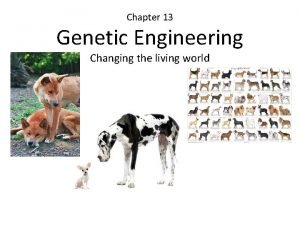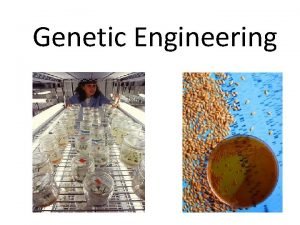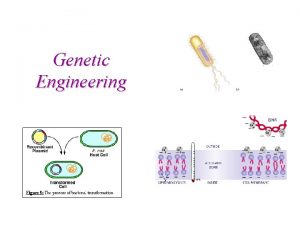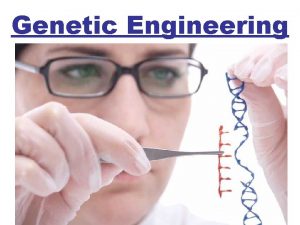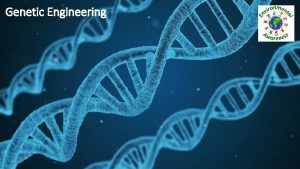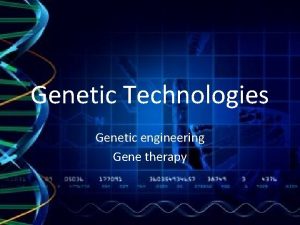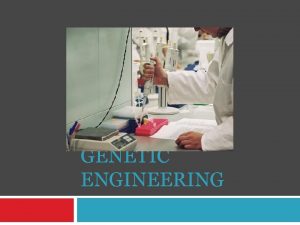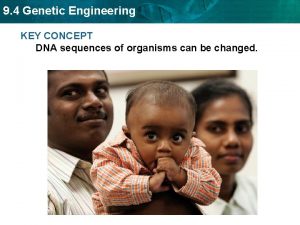9 4 Genetic Engineering KEY CONCEPT Genetic Engineering














- Slides: 14

9. 4 Genetic Engineering KEY CONCEPT Genetic Engineering is about changing the DNA sequences of organisms.

9. 4 Genetic Engineering Technique #1: Entire organisms can be cloned. • A clone is a genetically identical copy of a gene or of an organism. The original cat CC, short for Copy Cat, is the first successfully cloned Cat.

9. 4 Genetic Engineering • Cloning occurs in nature. – bacteria (binary fission) – some plants (from roots) – some simple animals (budding, regeneration)

9. 4 Genetic Engineering • Mammals can be cloned through a process called nuclear transfer. – nucleus is removed from an egg cell – nucleus of a cell from the animal to be cloned is implanted in the egg

9. 4 Genetic Engineering One of first mammals to be successfully cloned was a sheep.

9. 4 Genetic Engineering The adult sheep is Dolly, the first mammal cloned from an adult cell. The lamb is Dolly’s offspring, called Bonnie.

9. 4 Genetic Engineering • Cloning has potential benefits. – organs for transplant into humans – save endangered species • Cloning raises concerns. – low success rate – clones “imperfect” and less healthy than original animal – decreased biodiversity

9. 4 Genetic Engineering Technique #2: Recombinant DNA New genes can be added to an organism’s DNA. • Genetic engineering involves changing an organism’s DNA to give it new traits. • Genetic engineering is based on the use of recombinant DNA. • Recombinant DNA contains genes from more than one organism. (bacterial DNA)

9. 4 Genetic Engineering • Process involves: – Bacterial plasmids are often used to make recombinant DNA. – Steps: 1. plasmids are loops of DNA in bacteria 2. restriction enzymes cut plasmid and foreign DNA 3. foreign gene inserted into plasmid

9. 4 Genetic Engineering Technique #3: GMO’s A GMO = a “Genetically Modified Organism” • A “GMO” or transgenic organism has one or more genes from another organism inserted into its genome.

9. 4 Genetic Engineering • GMO (Transgenic) bacteria can be used to produce human proteins. – gene inserted into plasmid – plasmid inserted into bacteria – bacteria express the gene • GMO (Transgenic) plants are common in agriculture. – transgenic bacteria infect a plant – plant expresses foreign gene – many crops are now genetically modified (GM)

9. 4 Genetic Engineering Examples of how transgenic bacteria and plants are being used: 1. Transgenic Bacteria Now make insulin, growth hormone, and clotting factor cheaply and in great abundance) 2. Transgenic Plants 52% of soybeans and 25% of corn are transgenic Different varieties are resistant to disease, produce their own insecticide, resist weed-killing chemicals, and/or have increased vitamin content

9. 4 Genetic Engineering • GMO (Transgenic) animals are used to study diseases and gene functions. – Ex. transgenic mice used to study development and disease – gene “knockout mice” used to study gene function Knockout mouse on left lacks gene for protein leptin, which helps to control food intake. Used in obesity studies.

9. 4 Genetic Engineering • Scientists have concerns about some uses of genetic engineering. – possible long-term health effects? of eating GM foods – possible effects of GM plants on ecosystems and biodiversity ?
 Specation
Specation Genetic programming vs genetic algorithm
Genetic programming vs genetic algorithm Genetic programming vs genetic algorithm
Genetic programming vs genetic algorithm Genetic drift vs genetic flow
Genetic drift vs genetic flow Genetic drift vs genetic flow
Genetic drift vs genetic flow Concept map minerals
Concept map minerals Lesson 1 waves answer key
Lesson 1 waves answer key Chapter 11 genetic disorders concept mapping
Chapter 11 genetic disorders concept mapping Key patners
Key patners Key partners key activities key resources
Key partners key activities key resources Brainpop heredity worksheet answer key
Brainpop heredity worksheet answer key Meiosis and genetic variation usatestprep
Meiosis and genetic variation usatestprep Section 9-2 review genetic crosses answer key
Section 9-2 review genetic crosses answer key Insulin bacteria genetic engineering
Insulin bacteria genetic engineering Section 13-1 changing the living world
Section 13-1 changing the living world














